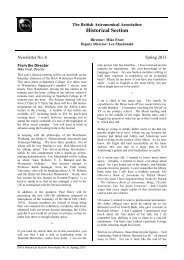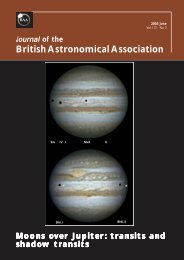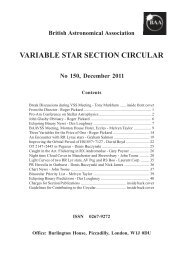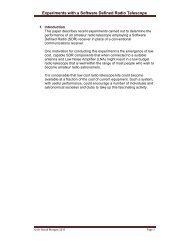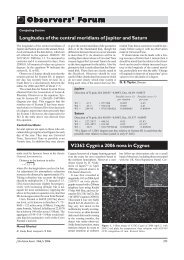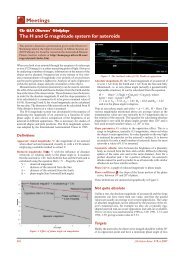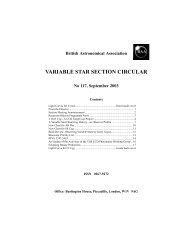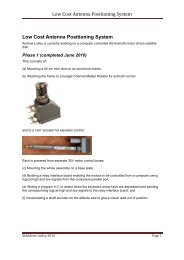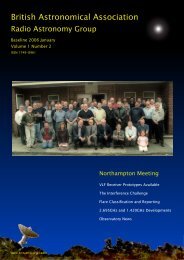Letters
Letters
Letters
Create successful ePaper yourself
Turn your PDF publications into a flip-book with our unique Google optimized e-Paper software.
<strong>Letters</strong><br />
<strong>Letters</strong><br />
‘Centenaries for 2006’<br />
From Dr Robert Argyle, President, the Webb<br />
Society<br />
Barry Hetherington’s list of centenaries for<br />
2006 in the December Journal [JBAA, 115(6),<br />
p.343] contains an important omission – the<br />
bicentenary of the birth of Thomas William<br />
Webb. The well-known Victorian populariser<br />
of astronomy was born on 1806<br />
December 14, but the year of birth is occasionally<br />
given erroneously as 1807 (see, for<br />
instance, the obituary in MNRAS, XLVI,<br />
198, 1886).<br />
The documentary evidence for 1806<br />
comes from the following sources and I am<br />
grateful to Mark and Janet Robinson, editors<br />
of a forthcoming biography of Webb,<br />
for the details.<br />
Firstly, in Hereford Record Office there<br />
is a microfilm of Ross Church registers with<br />
an entry for a christening on Sunday, 1806<br />
Dec 28: ‘Thomas William, son of John (Curate)<br />
& Sarah’. In addition, in papers in the<br />
Hereford Cathedral Library in which Thomas<br />
has written anecdotes told to him by<br />
his father and adds his own comments, there<br />
is the following in Thomas’ own hand:<br />
‘When my father was Curate to Rev. Thomas<br />
Underwood, Rector of Ross, at the<br />
beginning of the present century (during<br />
which time I was born, at a house called<br />
The Cottage, on the Walford Road, Dec.<br />
14th 1806) ....’.<br />
The Webb Society will be celebrating<br />
‘Webb 200’ at the Institute of Astronomy,<br />
Cambridge on 2006 December 2 and the<br />
speakers will include Mr and Mrs Robinson.<br />
R. W. Argyle<br />
Lyndhurst, Ely Road, Waterbeach, Cambridge CB5<br />
9NW. [rwa@ast.cam.ac.uk]<br />
Richard Baum and<br />
the Walter H. Haas<br />
Award<br />
From Mr Robert Garfinkle<br />
In regards to the article in the December 2005<br />
issue about Richard Baum’s receiving the<br />
ALPO Walter H. Haas Award for 2005<br />
(page 311), I want you to know that Richard<br />
was the first and only recipient to receive a<br />
unanimous vote by the selection committee<br />
for the Walt H. Haas Award.<br />
Robert A. Garfinkle, FRAS<br />
32924 Monrovia Street, Union City, CA 94587,<br />
USA. [ragarf@earthlink.net]<br />
From Dr Darren Beard<br />
I am writing concerning one of the events<br />
listed in the ‘Centenaries for 2006’ article in<br />
the December 2005 issue of the Journal.<br />
For 1606, it is stated ‘on 4th December<br />
Jupiter was occulted by Mars, seen from<br />
China’. In fact, there was no occultation of<br />
Jupiter by Mars on this date. Referring to<br />
Meeus J. (More Mathematical Astronomy<br />
Morsels, Willmann-Bell, 2002) it can be seen<br />
that no mutual occultation of planets occurred<br />
in 1606. The last Jupiter occultation<br />
by Mars occurred on 1387 Sep 22; the next<br />
such event is not until 2223 Dec 02.<br />
Calculations by the writer show that on<br />
1606 Dec 04 (Julian calendar) Mars passed<br />
within 32" of Jupiter as seen from China.<br />
This could well have been thought to be an<br />
occultation when observed without telescopic<br />
aid.<br />
Darren Beard<br />
18 Cumberland Avenue, Chandlers Ford, Eastleigh,<br />
Hampshire SO53 2JX. [darren_beard@uk.ibm.com]<br />
From the BAA Honorary Librarian<br />
The BAA Library collection of slides for<br />
loan by members is very deficient in slides<br />
of recent comets, aurorae etc. I would like<br />
to ask if any member would be prepared<br />
to provide slides of for example comet<br />
Hale–Bopp, comet Hyakutake, aurora<br />
displays, planetary images, eclipses (solar<br />
and lunar) etc. (including details of event,<br />
instrument, location and date) or any other<br />
astronomical phenomena which would be<br />
of interest to members, and which could<br />
be used to ilustrate talks or lectures. The<br />
copyright would of course be retained by<br />
the owner, and also due acknowledgment<br />
would be made.<br />
Anthony Kinder<br />
16 Atkinson House, Catesby Street, London SE17<br />
1QU. [anthony_kinder@hotmail.com]<br />
The brightest feature on the Moon?<br />
From Dr Richard McKim<br />
On the evening of 2005 December 11 I was<br />
pottering about in my observatory, trying to<br />
make videos of Mars and the ten-day old<br />
Moon. I am an inexperienced webcam user,<br />
and fear that I shall never be as good at it as I<br />
should like to be. As I adjusted the declination<br />
slow motion after imaging the ‘Moon Maiden’<br />
and other classic lunar features, I was struck<br />
by the intense brilliance of some small patches<br />
at the northern edge of a crater which I later<br />
identified with the help of the Hatfield Lunar<br />
Atlas as being the feature named Werner. On<br />
the monitor of my laptop computer the<br />
patches were really outstanding. After successfully<br />
imaging Werner I looked visually to<br />
confirm their brilliance with the eye. Through<br />
the wider field of the eyepiece it was clear<br />
that there were other really brilliant crater walls<br />
and patches catching sunlight at just the right<br />
angle, but the impression of Werner somehow<br />
being exceptional remained.<br />
Later, looking in my library at the classic<br />
Moon books by Elger and Goodacre I discovered<br />
that I was not the first to have been struck<br />
by the brilliance of these spots. Indeed, Walter<br />
Goodacre wrote: ‘At the foot of the N.E. slope<br />
a very bright spot develops under a high light<br />
above five miles square and covering a crater.<br />
This Madler thought was the brightest spot<br />
on the Moon. Webb, however, was never able<br />
to find it of the specified brightness and thinks<br />
it may have faded since Madler’s time.’ 1<br />
Slides of recent<br />
comets and other<br />
phenomena<br />
This episode prompted me to write to the<br />
Journal to offer a very imperfect stacked<br />
image of Werner, and to ask our readers if<br />
they can answer the following question:<br />
‘Which is the brightest feature on the Moon?’<br />
It may be an old debate, but what is the<br />
modern answer?<br />
Richard McKim<br />
16 Upper Main Street, Upper Benefield, Peterborough<br />
PE8 5AN. [RMckim5374@aol.com]<br />
1 W. Goodacre, The Moon, Pardy & Son,<br />
Bournemouth, 1931<br />
Crater Werner imaged in slightly unsteady<br />
seeing on 2005 December 11d 16h<br />
45m with a 410mm Dall−Kirkham Cassegrain<br />
at f/25, showing the bright spots<br />
in the north. (Toucam Pro webcam,<br />
Baader IR/UV blocking filter, processed<br />
with Registax 3). South is roughly at the<br />
top. Richard McKim<br />
J. Br. Astron. Assoc. 116, 1, 2006 9
From Mr James Abbott<br />
David Frydman (JBAA <strong>Letters</strong>, 2005<br />
December) gave an interesting account of the<br />
effect on the night sky of an electricity<br />
blackout over London.<br />
About a year ago, a similar event occurred<br />
on a clear night here in mid-Essex. About half<br />
of the nearby market town of Witham (pop.<br />
25,000) suffered a power cut and from the<br />
adjacent more rural areas the light pollution<br />
dome over the town also halved in its extent.<br />
Normally it produces an orange glow to around<br />
40° in the southern sky as seen from where I<br />
live, the town centre being 5km away.<br />
Due to the power cut, for the first time<br />
since moving here 15 years ago I could see<br />
constellations in the southern sky. Usually the<br />
light dome in the south obscures all stars below<br />
about 3rd magnitude and is now so bad<br />
that it clearly casts shadows, even though we<br />
have no actual streetlights within 1km.<br />
I would estimate that in the best parts of<br />
the sky here (around the zenith and to the<br />
east and north), the limiting magnitude on a<br />
good night has declined from about +5m.5 15<br />
years ago to around +5m.1 now. This is of<br />
course not just light pollution from one town<br />
but the growth of all the towns in the area,<br />
and the rapid spread of artificial lights in new<br />
and established built up areas, as well as from<br />
farms, rural business premises, etc.<br />
The blackout showed the immediate benefit<br />
of reducing the amount of light going into<br />
the night sky – which could equally be<br />
10<br />
<strong>Letters</strong><br />
The worsening curse of light pollution<br />
From M. Jean Meeus<br />
On 2005 November 5, Mr Joe Rao of<br />
Putnam Valley, NY, posted a message on<br />
the Solar Eclipses Mailing List in which he<br />
wrote that ‘a veritable proliferation of solar<br />
eclipses visible over a specific location over<br />
a very short time span’ is possible. He had<br />
found some instances where four solar<br />
eclipses will be visible during a span of less<br />
than 18 months: New York in 2638−2640,<br />
Los Angeles in 2044−2046, and Bogotá in<br />
2345−2346.<br />
Of course, in most cases all these eclipses<br />
are partial at the given place. An eclipse is<br />
considered to be ‘visible’ when at least one<br />
of its three characteristic phases occurs above<br />
the horizon: first contact (beginning of partial<br />
eclipse), maximum, and last contact.<br />
We wrote a computer program to search<br />
for such cases of proliferation of four solar<br />
eclipses during the period 1600−2800. No<br />
cases were found for Athens, Berlin, Cape<br />
Town, Edinburgh, Istanbul, London, Moscow,<br />
Paris, Rome, Sydney and Tokyo. But<br />
one case was found for Bombay (in 2359−<br />
2361), Boston (2692−2694), Madrid (1780−<br />
1782); two cases occur at Bogotá, Cairo,<br />
achieved without putting residents to the inconvenience<br />
of power cuts if sky friendly<br />
policies were adopted. Although new planning<br />
guidance aimed at reducing light pollution<br />
is being introduced and for the first time<br />
excess light is to be made a statutory nuisance,<br />
the night sky over the UK will still<br />
have very limited official protection.<br />
The astronomical community numbers<br />
many thousands in the UK. Given the speed<br />
at which light pollution is worsening in many<br />
parts of the UK I believe that we are going to<br />
have to step up a gear in campaigning if the<br />
situation is to be stabilised, let alone reversed.<br />
I would urge all BAA members and friends<br />
who are not already members of the Campaign<br />
for Dark Skies (CfDS) to join and support<br />
their excellent work and get involved. It<br />
is unlikely that anyone other than the astronomical<br />
community will engage in this vital<br />
work in an effective way.<br />
As well as ongoing national campaigns,<br />
much can be achieved locally. Lobbying highways<br />
authorities on streetlighting policies,<br />
monitoring planning applications and approaching<br />
individual firms and properties has<br />
in my experience had generally positive results<br />
– in many cases those responsible for<br />
light pollution have little or no idea of the<br />
problem and are happy to help.<br />
James Abbott<br />
Rivenhall Observatory, Waterfall Cottages, Rivenhall,<br />
Witham, Essex CM8 3PR. [james-abbott @lineone.net]<br />
Proliferation of local solar eclipses<br />
Hong Kong, Jerusalem and Washington D.C.;<br />
three at Calcutta, Dakar and Khartoum; and<br />
no less than four at Bangkok and Miami.<br />
No case was found for the North Pole,<br />
but for the South Pole we found no less than<br />
4 cases: in 1782−1784, 2824−2826, 2936−<br />
2938, and 2954−2956.<br />
We then repeated the calculation for the<br />
much longer period from 2000 BC to AD<br />
3400. We found a total of eleven ‘proliferations’<br />
at the South Pole, but still no case at<br />
the North Pole. This is the more surprising<br />
because at the North Pole the Sun remains<br />
one week longer above the horizon than at<br />
the South Pole. At epoch 2000, the Sun’s<br />
declination is positive during a period of<br />
186.4 days, negative during only 178.8 days.<br />
But there is a further surprise: the eleven<br />
cases of proliferation at the South Pole all take<br />
place during a time span of 17, not 18 months.<br />
For instance, the last case was with the following<br />
eclipses: 1782 October 7, 1783 March 3,<br />
1783 September 26, and 1784 February 20.<br />
Jean Meeus<br />
Leuvense steenweg 312, box 8, B-3070 Kortenberg,<br />
Belgium. [jmeeus@compuserve.com]<br />
Observing the<br />
aurora from the UK<br />
From the Director of the Aurora Section,<br />
1982–2005<br />
At the joint meeting with the Royal Meteorological<br />
Society on 2004 November 27, 1<br />
Mike Pinnock said that there was sadly little<br />
that UK amateur observers could usefully<br />
do in the observation of the aurora, and<br />
that the UK was not far enough north.<br />
Before my observing team becomes demoralised,<br />
may I remind them that the primary<br />
objective of the Aurora Section is to<br />
make an accurate historical record of auroral<br />
events, their activity and geographic extent.<br />
This work continues the data collection for<br />
this phenomenon from archaic times to the<br />
present day. One never knows when such<br />
records may be of value to researchers now<br />
and in the future.<br />
For example, in the 2005 August issue of<br />
Astronomy & Geophysics 2 Giles Harrison<br />
analysed aurora observations made between<br />
1771 and 1805 by Thomas Hughes at Stroud.<br />
These confirmed the period from 1778 to<br />
1788 to be quite active and 1796 to 1803 to<br />
be a period of no activity. Harrison confirmed<br />
these variations by reference to European<br />
records. I have independently confirmed the<br />
results as given by Réthley & Berkes’ list of<br />
Hungarian aurorae in that period. 3<br />
Although Hughes’ observations were that<br />
of a point location, subject to problems with<br />
cloud and observer availability, Harrison has<br />
correlated them with sunspot high maxima<br />
in 1778 and 1787 and the Dalton solar minimum<br />
period around 1800.<br />
The Aurora Section records from 1962 to<br />
date permit the frequency of the aurora at<br />
Stroud to be calculated for the present era.<br />
Such a data set enables the situation in the<br />
two periods to be compared, should anyone<br />
wish to do so. From 1976 to 2004 some 67<br />
aurorae were reliably observed south of Birmingham,<br />
of which at least 15 were major<br />
auroral storms. One can hardly say that<br />
southern England was not far enough north<br />
to partake in the study of the historical distribution<br />
of mid-latitude storm aurorae.<br />
To all members my advice would be to<br />
‘observe everything that shines’, 4 and you<br />
don’t even need a telescope.<br />
Ron Livesey<br />
Block 1, Flat 2, East Parkside, Edinburgh EH16 5XJ.<br />
References<br />
1 Pinnock M., ‘Aurorae’, in Ford D., J. Brit.<br />
Astron. Assoc., 115(4), 226 (2005)<br />
2 Harrison G., ‘Aurora diaries’, Astron. &<br />
Geophys., 46(4), 4.31 (2005)<br />
3 Réthley A. & Berkes A., Nordlightbeobachtungen<br />
in Ungarn (1523−1960), Akadémiai<br />
Kiadó, Budapest, 1963<br />
4 Gavine D. M., ‘Observing the aurora’, J.<br />
Brit. Astron. Assoc., 114(5), 293 (2004)<br />
J. Br. Astron. Assoc. 116, 1, 2006



